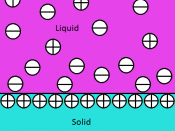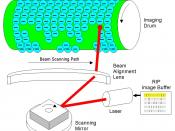Photocopiers and laser printers are staple pieces of equipment in any office setting. Not that long ago, all copies were done by use of carbon paper or tedious recopying by hand. This modern invention that is so taken for granted in today's fast paced society was a long time in coming. The first photocopy, made of moss spores, gave way to several different types of polymer infused toners. The use of this innovation has allowed not only cheap, clean copies, but also a method by which the origin of these copies can be traced.
Before the advent of the photocopying machine, simple and cheap copying methods were both messy and crude. One of the earliest forms was the hectograph. The master copy was written on a piece of paper with a special ink. The master was pressed faced down on the tray of gelatin which dissolved and absorbed the ink.
Most blank sheets of paper were pressed on the inked gelatin and a few inferior copies could be transferred this way. (Bunce)
After the hectograph came the ditto process. This was where a special ink impression was made on the back of the master sheet. This master was mounted on a drum in a machine like a small printing press. On each rotation of the drum, methyl alcohol dissolves a bit of the ink and it is transferred to a blank sheet of paper. This process only made about twenty-five copies. (Bunce) About the same time, the Gestetner process was also employed. This technique consisted of typing, or writing with a stylus on a special wax-impregnated paper. The wax was removed where the typewriter struck it, making the paper porous to ink. Again, a small rotary printing press was used. It was messy, but it was able to produce...


